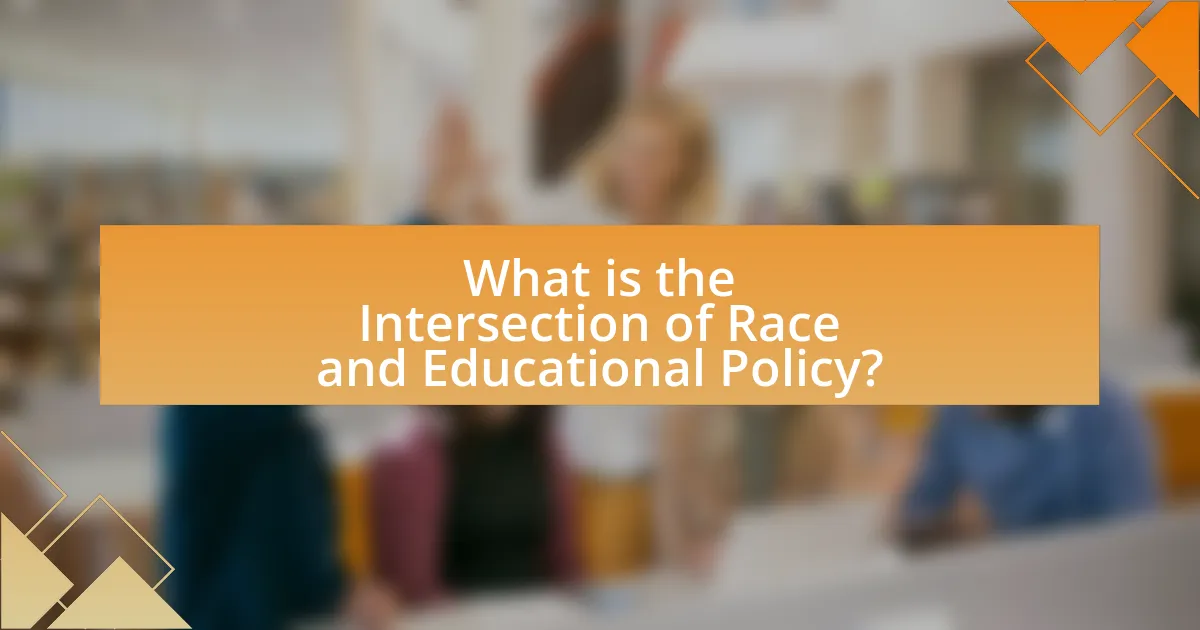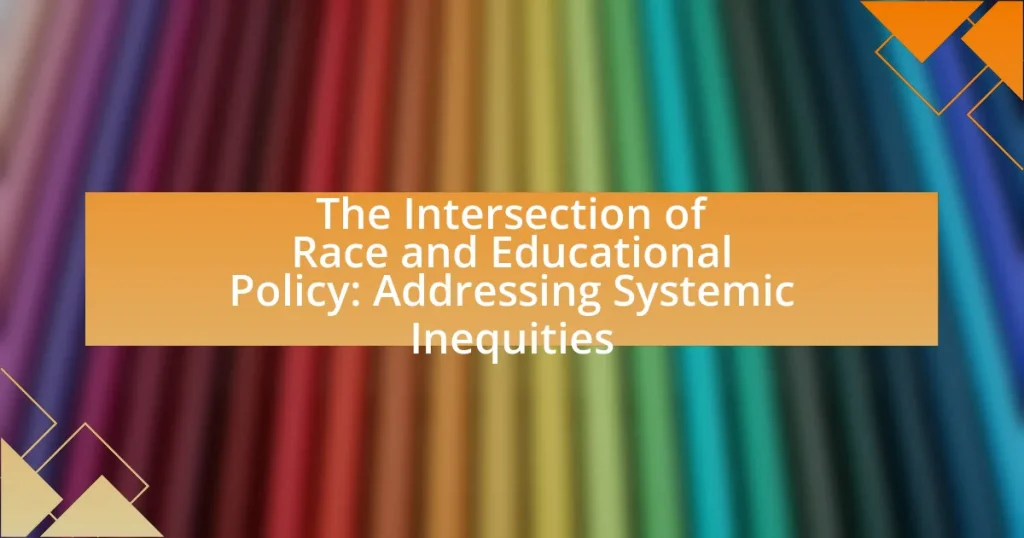The article examines the intersection of race and educational policy, highlighting how racial dynamics shape the development, implementation, and outcomes of educational policies. It discusses systemic inequities, such as disparities in funding, access to quality resources, and biased disciplinary practices that disproportionately affect students of color. Historical factors, current challenges, and the role of various stakeholders, including educators and community organizations, are analyzed to understand their influence on policy decisions aimed at addressing these inequities. The article emphasizes the importance of equitable funding, inclusive curricula, and targeted policy reforms to promote educational equity and improve outcomes for marginalized racial groups.

What is the Intersection of Race and Educational Policy?
The intersection of race and educational policy refers to how racial dynamics influence the formulation, implementation, and outcomes of educational policies. Educational policies often reflect and perpetuate systemic inequities, as evidenced by disparities in funding, access to quality resources, and disciplinary practices that disproportionately affect students of color. For instance, research from the U.S. Department of Education indicates that schools serving predominantly Black and Hispanic students receive significantly less funding than those serving predominantly white students, highlighting the racial disparities embedded in educational policy. Additionally, studies show that students of color face higher rates of suspension and expulsion, which further exacerbates educational inequities.
How does race influence educational policy decisions?
Race significantly influences educational policy decisions by shaping the priorities and frameworks within which policies are developed and implemented. Policymakers often consider racial demographics when addressing issues such as funding allocation, curriculum development, and disciplinary practices, which can lead to systemic inequities. For instance, studies have shown that schools in predominantly minority neighborhoods receive less funding compared to those in predominantly white areas, perpetuating disparities in educational resources and opportunities. Additionally, racial biases can affect disciplinary policies, resulting in disproportionate suspension and expulsion rates for students of color, as highlighted in the U.S. Department of Education’s Office for Civil Rights data. These factors illustrate how race is a critical determinant in the formulation and effectiveness of educational policies, ultimately impacting the quality of education received by different racial groups.
What historical factors contribute to current educational policies regarding race?
Historical factors such as segregation laws, the Civil Rights Movement, and landmark court cases significantly contribute to current educational policies regarding race. Segregation laws, particularly the Jim Crow laws, enforced racial separation in schools, leading to systemic inequities in educational resources and opportunities for minority students. The Civil Rights Movement, culminating in the 1964 Civil Rights Act, aimed to dismantle these inequities and established a legal framework for addressing discrimination in education. Landmark court cases, such as Brown v. Board of Education in 1954, declared racial segregation in public schools unconstitutional, setting a precedent for future educational policies that promote equity and inclusion. These historical events collectively shape the ongoing discourse and legislative efforts aimed at addressing systemic inequities in education today.
How do systemic inequities manifest in educational settings?
Systemic inequities manifest in educational settings through disparities in resources, access to quality teachers, and curriculum quality. For instance, schools in low-income areas often receive significantly less funding than those in affluent neighborhoods, leading to inadequate facilities and limited educational materials. According to the U.S. Department of Education, schools serving predominantly students of color are more likely to have inexperienced teachers and fewer advanced placement courses, which directly impacts student achievement. Furthermore, standardized testing and disciplinary policies disproportionately affect marginalized students, contributing to higher dropout rates and lower college enrollment. These factors collectively illustrate how systemic inequities create barriers to equitable education for all students.
Why is addressing systemic inequities in education important?
Addressing systemic inequities in education is important because it ensures equal access to quality education for all students, regardless of their background. Systemic inequities often lead to disparities in educational resources, opportunities, and outcomes, which can perpetuate cycles of poverty and limit social mobility. For instance, research by the National Center for Education Statistics indicates that schools in low-income areas receive significantly less funding than those in affluent neighborhoods, resulting in fewer qualified teachers and inadequate facilities. By addressing these inequities, educational policies can promote fairness, enhance student achievement, and contribute to a more equitable society.
What are the long-term effects of systemic inequities on students of different races?
Systemic inequities have long-term effects on students of different races, leading to disparities in educational attainment, economic opportunities, and social mobility. Research indicates that students from marginalized racial backgrounds often experience lower academic performance due to inadequate resources, biased disciplinary practices, and limited access to advanced coursework. For instance, a study by the National Center for Education Statistics found that Black and Hispanic students are more likely to attend underfunded schools, which correlates with lower graduation rates and college enrollment. Additionally, systemic inequities contribute to a cycle of poverty, as these students face barriers in accessing higher education and well-paying jobs, perpetuating socioeconomic disparities across generations.
How do systemic inequities impact educational outcomes and opportunities?
Systemic inequities significantly hinder educational outcomes and opportunities by perpetuating disparities in access to quality resources, funding, and support systems. For instance, schools in low-income areas often receive less funding, leading to larger class sizes, outdated materials, and fewer extracurricular programs, which negatively affect student performance. Research from the National Center for Education Statistics indicates that students in high-poverty schools are less likely to have access to advanced coursework and experienced teachers, resulting in lower graduation rates and college enrollment. Additionally, systemic biases related to race and socioeconomic status contribute to discriminatory disciplinary practices, further exacerbating educational inequities.

What are the key components of educational policy related to race?
Key components of educational policy related to race include equitable funding, inclusive curriculum, anti-discrimination measures, and access to quality resources. Equitable funding ensures that schools serving racially marginalized communities receive adequate financial support, addressing disparities highlighted by the U.S. Department of Education, which found that schools with higher percentages of students of color often receive less funding. An inclusive curriculum incorporates diverse perspectives and histories, fostering a sense of belonging and understanding among students. Anti-discrimination measures, such as those mandated by Title VI of the Civil Rights Act of 1964, prohibit racial discrimination in federally funded programs, ensuring that all students have equal opportunities. Access to quality resources, including experienced teachers and advanced coursework, is critical for closing achievement gaps, as research from the National Center for Education Statistics indicates that students in racially diverse schools often face significant resource shortages.
What types of policies exist to address racial inequities in education?
Policies that address racial inequities in education include affirmative action, equitable funding formulas, and culturally relevant pedagogy. Affirmative action policies aim to increase the representation of historically marginalized groups in educational institutions by considering race as one of several factors in admissions processes. Equitable funding formulas seek to allocate resources based on student needs rather than property taxes, which often disadvantage schools in predominantly minority communities. Culturally relevant pedagogy emphasizes teaching methods that reflect the diverse backgrounds of students, promoting engagement and academic success. These policies are supported by research indicating that equitable funding and inclusive teaching practices can significantly improve educational outcomes for students of color.
How do affirmative action policies affect educational access for marginalized groups?
Affirmative action policies enhance educational access for marginalized groups by promoting diversity and providing opportunities that counteract systemic inequities. These policies often include measures such as targeted recruitment, financial aid, and admissions preferences for underrepresented students, which help to level the playing field in educational institutions. For instance, research from the National Bureau of Economic Research indicates that affirmative action in college admissions significantly increases enrollment rates for Black and Hispanic students, thereby contributing to a more diverse educational environment. This increased access not only benefits the individuals directly involved but also enriches the educational experience for all students by fostering a broader range of perspectives and ideas.
What role do funding disparities play in educational equity?
Funding disparities significantly hinder educational equity by creating unequal access to resources among schools, particularly affecting marginalized communities. Schools in affluent areas often receive more funding through local property taxes, leading to better facilities, advanced courses, and experienced teachers. In contrast, schools in low-income neighborhoods struggle with inadequate funding, resulting in larger class sizes, outdated materials, and limited extracurricular opportunities. Research from the U.S. Department of Education indicates that schools serving predominantly students of color receive about $23 billion less in funding than those serving mostly white students. This systemic inequity perpetuates achievement gaps and limits opportunities for students from disadvantaged backgrounds, ultimately affecting their long-term educational and economic outcomes.
How do various stakeholders influence educational policy regarding race?
Various stakeholders, including government agencies, educational institutions, community organizations, and advocacy groups, influence educational policy regarding race by shaping legislation, funding, and public discourse. Government agencies establish laws and regulations that mandate equitable practices in schools, such as the Every Student Succeeds Act, which aims to close achievement gaps among racial groups. Educational institutions implement policies that reflect these laws, often influenced by community feedback and advocacy efforts. Community organizations mobilize grassroots support and raise awareness about racial inequities, pushing for reforms that address systemic issues. Advocacy groups, such as the NAACP and the Education Trust, provide research and policy recommendations that inform decision-makers, highlighting the need for culturally responsive curricula and equitable resource allocation. Together, these stakeholders create a multifaceted approach to addressing racial disparities in education.
What role do educators play in shaping policies that address racial inequities?
Educators play a crucial role in shaping policies that address racial inequities by advocating for equitable practices and influencing decision-making processes within educational systems. They provide firsthand insights into the challenges faced by marginalized students, which can inform policy development aimed at reducing disparities. For instance, educators often participate in committees and forums where they can voice the needs of their students, thereby directly impacting policy changes. Research indicates that when educators engage in policy advocacy, such as through organizations like the National Education Association, they can effectively push for reforms that promote equity, such as culturally relevant curricula and equitable funding models. This involvement not only highlights the importance of educator perspectives but also demonstrates their capacity to drive systemic change in addressing racial inequities in education.
How do community organizations advocate for changes in educational policy?
Community organizations advocate for changes in educational policy by mobilizing grassroots efforts, conducting research, and engaging in policy dialogue. These organizations often represent marginalized communities and utilize data to highlight systemic inequities in education, such as disparities in funding and access to resources. For example, the Education Trust has documented how schools in low-income areas receive significantly less funding than those in affluent neighborhoods, which underscores the need for policy reform. Additionally, community organizations often collaborate with policymakers to propose legislation that addresses these inequities, ensuring that the voices of affected communities are heard in the decision-making process.

What are the challenges in implementing equitable educational policies?
Implementing equitable educational policies faces several challenges, including systemic racism, funding disparities, and resistance to change. Systemic racism manifests in biased practices and policies that disadvantage marginalized groups, making it difficult to create an inclusive educational environment. Funding disparities often result in unequal resource allocation, where schools in affluent areas receive significantly more financial support than those in low-income neighborhoods, exacerbating educational inequities. Additionally, resistance to change from stakeholders, including policymakers and community members, can hinder the adoption of necessary reforms aimed at promoting equity. These challenges are supported by research indicating that schools serving predominantly minority populations often experience lower funding and resources, which directly impacts student outcomes.
What barriers exist in the enforcement of educational policies aimed at racial equity?
Barriers in the enforcement of educational policies aimed at racial equity include inadequate funding, lack of political will, and systemic biases within educational institutions. Inadequate funding often results in insufficient resources for schools serving marginalized communities, hindering the implementation of equitable programs. Lack of political will manifests as insufficient commitment from policymakers to prioritize and enforce these policies, often influenced by public opinion or political agendas. Systemic biases, including implicit biases among educators and administrators, can lead to discriminatory practices that undermine the goals of racial equity policies. Research by the National Education Association highlights that these barriers contribute to persistent achievement gaps and inequitable access to quality education for students of color.
How do political and social climates affect policy implementation?
Political and social climates significantly influence policy implementation by shaping public opinion, legislative priorities, and resource allocation. For instance, during periods of heightened social activism, such as the civil rights movement, policies aimed at addressing racial inequities in education gained traction, leading to landmark legislation like the Elementary and Secondary Education Act of 1965. Conversely, a politically polarized environment can hinder the enactment of progressive educational reforms, as seen in recent debates over funding for diverse educational programs. Research indicates that when social movements align with political will, policies addressing systemic inequities are more likely to be effectively implemented, demonstrating the critical interplay between these climates and educational policy outcomes.
What resistance do policymakers face when addressing systemic inequities?
Policymakers face significant resistance from entrenched interests, public opinion, and institutional inertia when addressing systemic inequities. These challenges arise because existing power structures often benefit from the status quo, making it difficult to implement reforms that would disrupt these advantages. For instance, research by the National Education Association highlights that opposition from stakeholders, including parents and local governments, can hinder the adoption of equitable policies in education. Additionally, public resistance may stem from misconceptions about the implications of equity initiatives, leading to a lack of support for necessary changes.
How can effective strategies be developed to overcome these challenges?
Effective strategies to overcome challenges at the intersection of race and educational policy can be developed through comprehensive data analysis, community engagement, and targeted policy reforms. Comprehensive data analysis allows stakeholders to identify specific inequities in educational access and outcomes, as evidenced by the National Center for Education Statistics, which highlights disparities in graduation rates among different racial groups. Community engagement ensures that the voices of marginalized communities are included in decision-making processes, fostering trust and collaboration. Targeted policy reforms, such as implementing equitable funding models and culturally relevant curricula, have been shown to improve educational outcomes for underrepresented students, as demonstrated by studies from the Education Trust. These approaches collectively create a framework for addressing systemic inequities in education.
What best practices can be adopted to ensure equitable educational policies?
To ensure equitable educational policies, it is essential to implement data-driven decision-making that identifies disparities in educational access and outcomes. This practice involves collecting and analyzing data on student demographics, achievement levels, and resource allocation to pinpoint inequities. For instance, the U.S. Department of Education’s Office for Civil Rights regularly publishes data that reveals achievement gaps among different racial and socioeconomic groups, highlighting the need for targeted interventions. Additionally, engaging diverse stakeholders, including parents, educators, and community leaders, in the policy-making process fosters inclusivity and ensures that the voices of marginalized communities are heard. Research from the National Education Association indicates that collaborative approaches lead to more effective and equitable policy outcomes. Finally, continuous professional development for educators on cultural competency and implicit bias can enhance teaching practices and promote an inclusive learning environment, as evidenced by studies showing improved student engagement and performance in diverse classrooms.
How can data be used to inform and improve educational policy decisions?
Data can be used to inform and improve educational policy decisions by providing evidence-based insights into student performance, resource allocation, and demographic disparities. For instance, analyzing standardized test scores can reveal achievement gaps among different racial and socioeconomic groups, prompting policymakers to implement targeted interventions. Research from the National Center for Education Statistics indicates that data-driven approaches can lead to a 10-20% increase in student achievement when policies are tailored to address identified needs. Furthermore, longitudinal data tracking student progress over time can help assess the effectiveness of specific programs, ensuring that resources are directed toward strategies that yield measurable improvements in educational equity.
What practical steps can educators take to promote equity in their classrooms?
Educators can promote equity in their classrooms by implementing differentiated instruction tailored to meet the diverse needs of all students. This approach allows teachers to provide various learning pathways, ensuring that each student can engage with the material in a way that suits their individual learning styles and backgrounds. Research indicates that differentiated instruction can lead to improved academic outcomes for marginalized groups, as it addresses specific barriers to learning (Tomlinson, 2001). Additionally, educators should actively incorporate culturally relevant pedagogy, which connects the curriculum to students’ cultural contexts, fostering a sense of belonging and engagement. Studies show that when students see their identities reflected in the curriculum, their academic performance and self-esteem improve (Ladson-Billings, 1994). Furthermore, establishing a classroom environment that prioritizes inclusivity and respect can help mitigate biases and promote a sense of community among students. By taking these practical steps, educators can create a more equitable learning environment that supports all students effectively.
How can teachers create inclusive environments that support all students?
Teachers can create inclusive environments that support all students by implementing differentiated instruction tailored to diverse learning needs. This approach allows educators to address varying abilities, learning styles, and cultural backgrounds, ensuring that every student has equitable access to education. Research indicates that differentiated instruction can lead to improved academic outcomes, as it fosters engagement and motivation among students from different backgrounds (Tomlinson, 2001). By utilizing strategies such as flexible grouping, varied assessment methods, and culturally relevant materials, teachers can effectively support the unique needs of each student, thereby promoting an inclusive classroom atmosphere.
What resources are available for educators to address racial inequities in education?
Educators can access various resources to address racial inequities in education, including professional development programs, curriculum guides, and community partnerships. Organizations such as the National Education Association provide training focused on culturally responsive teaching and anti-bias education. Additionally, the Teaching Tolerance project offers free resources and lesson plans aimed at promoting equity and inclusion in classrooms. Research from the Education Trust highlights the importance of data-driven approaches, encouraging educators to analyze student performance data to identify and address disparities. These resources collectively empower educators to create equitable learning environments and foster inclusive practices.



